Cooking at home is not only much healthier than eating out, it’s also easier on the pocket. To take your home cooking to another level, try growing your own indoor edible garden! You don’t need to clear out tons of space in your home. Just find a nook, corner, or countertop which gets a bit of sunlight and put your pots or planters there. Scroll down to read several indoor garden ideas to add more flavor to your homemade cooking!
Table of Contents
The best plants for your indoor garden
Different plants have different needs. Obviously, most thrive outdoors where there is plenty of sunlight, water, and humidity. However, with urbanization and the migration of people to concrete jungles, a.k.a. cities, indoor gardening is fast becoming a popular thing!
| Best herbs to grow indoors | Best vegetables for indoor garden | Best (dwarf) fruit-bearing trees you can grow indoors |
| Mint Chives Parsley Basil Cilantro Thyme Oregano Lemongrass Scallions | Lettuce Spinach Swiss chard Kale Microgreens such as chia Chili peppers Carrots Mushrooms Radishes | Strawberries Lemons Oranges Lime Fig Avocado Banana Ground cherries Peaches |
Seeds vs seedlings – what should you start with?
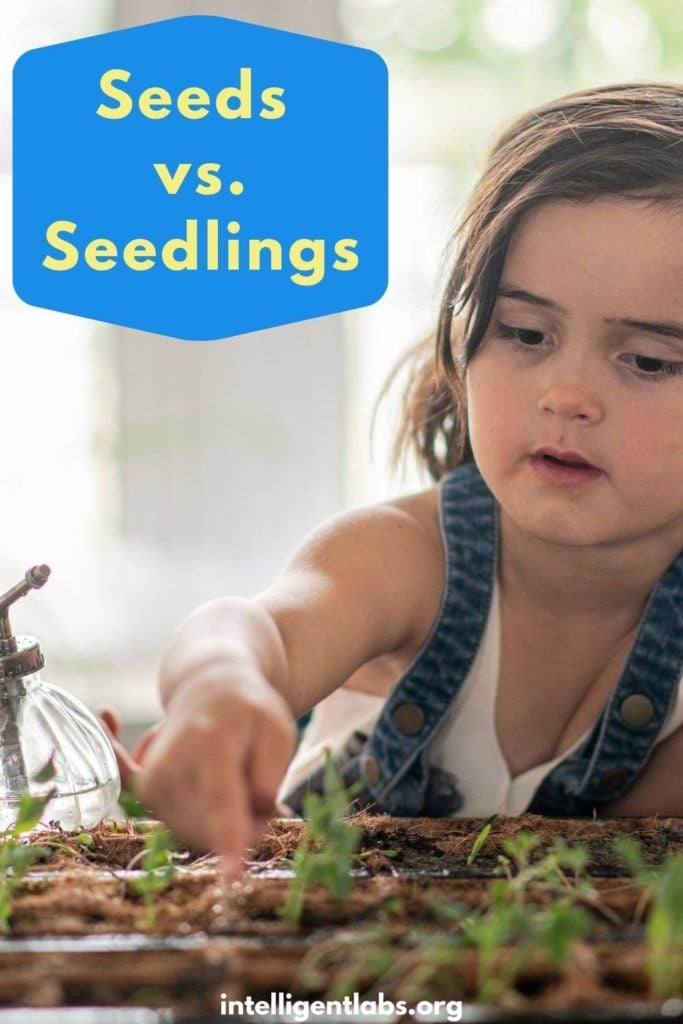
If you’re new to the world of indoor gardening, you’re probably wondering which is better for you to start with. Some people like to use seeds, others like to use seedlings. There’s really no right or wrong answer here since both have their pros and cons in terms of cost, time, availability, and survivability.
To start with, seeds are much cheaper than seedlings. A bag of seeds is much cheaper than a pack of seedlings. However, since you’re growing seeds from scratch, you also need to factor other expenses like garden soil, fertilizer, grow lights, heating mat, and of course, pots to put them in.
With seedlings, you pretty much get to fast-forward and skip the whole seed-growing process. Of course, you’ll still need to tend to the seedlings to make it grow into a proper plant. But you essentially save a whole lot of time with seedlings vs planting seeds. Take note that some seeds take much longer than others to sprout, so in this case, a seedling is definitely a much better option.
In terms of availability, seeds definitely win. They’re easier to come by and you can even store them for use later on (if you don’t want to plant everything at once). As for seedlings, you may need to hunt them down if your local nurseries don’t have them for sale yet.
Unfortunately, buying seedlings from farther away is not possible in a lot of places, simply because shipping live plants isn’t always feasible (they may not survive the journey). Seeds, on the other hand, will more than likely survive even a round-the-world trip!
Indoor garden ideas: Supplies you’ll need for your indoor garden

Before you buy your indoor garden supplies, figure out the plants you want to have and whether you’ll be using seeds or seedlings. This will have a direct impact on the supplies you’ll need to grow your garden.
- Pots – these come in different sizes, so you need to have an idea of how big your plant’s going to get. Pots that are too small can stunt the plant’s growth, while those that are too big can lead to root rot. The type of pot can also affect how it handles water. Plastic pots will retain more moisture while clay won’t.
- Soil – potting soil is important if you’re going to be planting your garden the traditional way. But if you’re thinking of using a hydroponic system (growing plants without soil), then you can remove soil from your list.
- Fertilizer – choose organic fertilizers for your indoor plants. Follow the instructions on the label if you want your plants to thrive.
- Lighting – some plants can survive on indirect sunlight for a few hours each day. Others need longer exposure to sunlight, in this case, a grow light may be necessary. There are different types of grow lights available with different spectrums to mimic sunlight.
- Space – in addition to putting your plants on open countertops, you may also want to consider using hanging baskets and hanging pots to free up space in your home.
- Water – plants need to drink too. But some plants need more water than others. Figure out your plant’s needs, so they don’t end up thirsty, or worse, drowned.
Alternatively, you can just buy an indoor gardening kit where you get everything you need in one package – seeds/seedlings, grow lights, pots, soil, etc. Of course, this may not be the most cost-effective option, but the upside is you don’t need to worry about buying your indoor gardening supplies one at a time!
What herbs can be planted together?
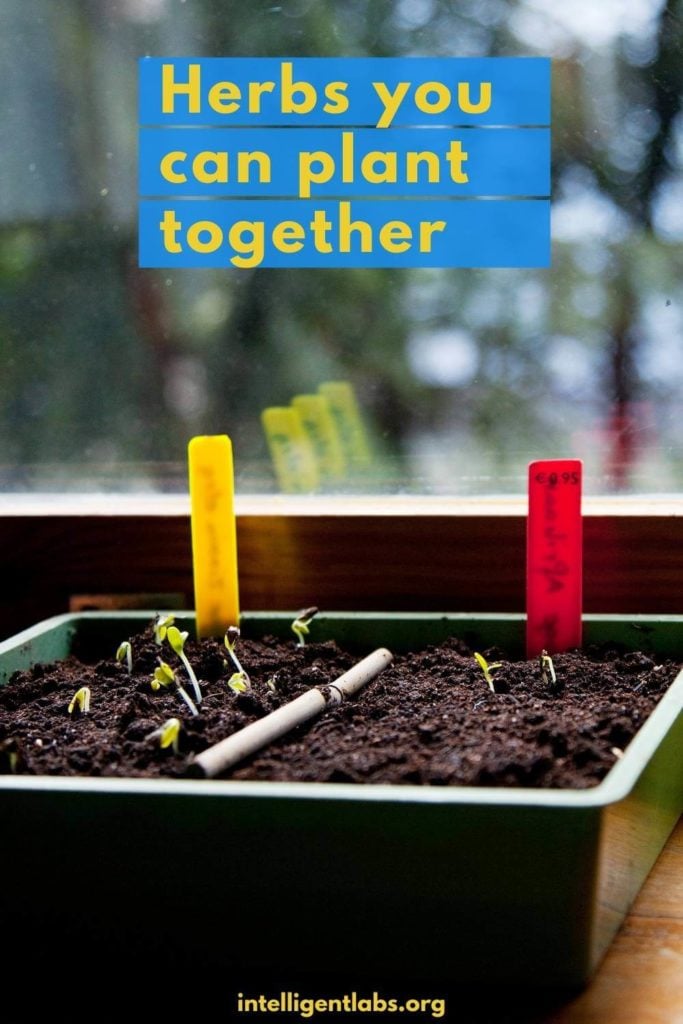
You don’t need one pot for each plant, well, unless you’re planting the more invasive mint… But fortunately, most herbs can be planted together! This is perfect if you’re trying to save some space in your home, or if you bought pots that are too roomy for one plant.
Generally, you can plant Mediterranean herbs together. These are herbs that are commonly found throughout the Mediterranean, a region with a fairly dry climate. So, as you can probably guess, these hardy plants will not require a lot of water to survive. It’s perfect for busy people who want to grow an indoor garden but are rarely home to look after them!
That said, here’s a list of Mediterranean herbs that you can plant together:
- Sage
- Thyme
- Rosemary
- Lavender
- Marjoram
- Oregano
On the other hand, moisture-loving herbs like parsley and basil will also do well in a single pot.
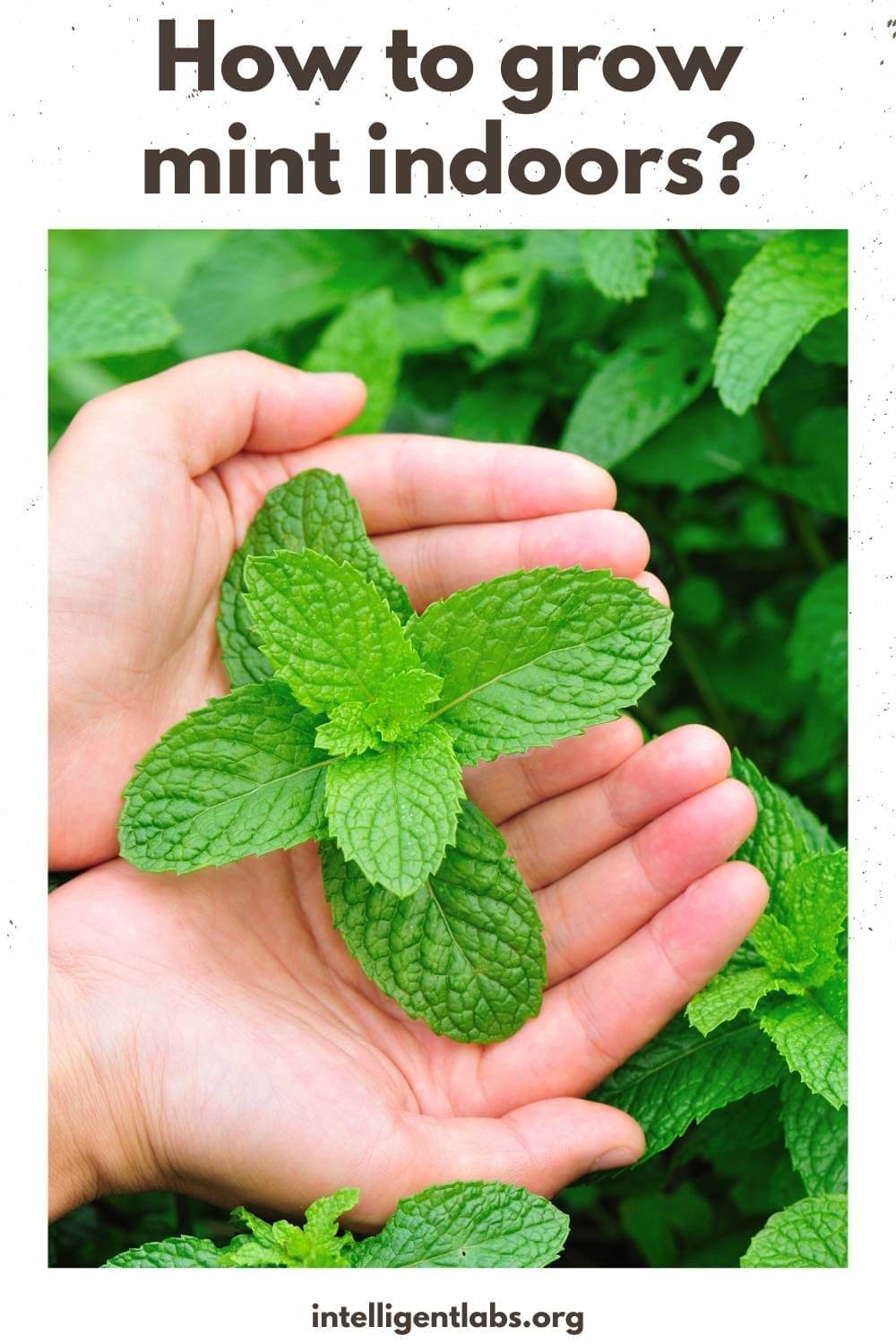
How to grow mint indoors?
As mentioned in the previous section, mint should be planted in its own pot. While mint is an herbal powerhouse, it is also a very aggressive plant. Take note that there are many different varieties of mint.
Planting them too close together (even in separate pots) can lead to cross-pollination, which isn’t really a bad thing if you like experiments. But it may lead to an undesirable result flavor-wise, which won’t be good for your homemade dishes!
The good thing is that mint is very easy to grow indoors. It’s relatively low maintenance and it even acts as an insect repellent! It repels bugs like mosquitoes, spiders, and ants.
You just need to give your mint plant ample space, so it doesn’t take over your indoor garden. For more tips on how to grow mint indoors, check out this article.
Still on the fence about starting your own indoor garden? Here are the benefits of starting one!
Aside from making your house look cool, here are some other benefits for planting your own herbs at home:
- You can plant as many or as little as you want
Whether you want to plant 5 types of herbs or 20, it’s totally up to you! Fortunately, the most popular herbs can survive indoors (usually near a window).
- You’ve got full control over your garden
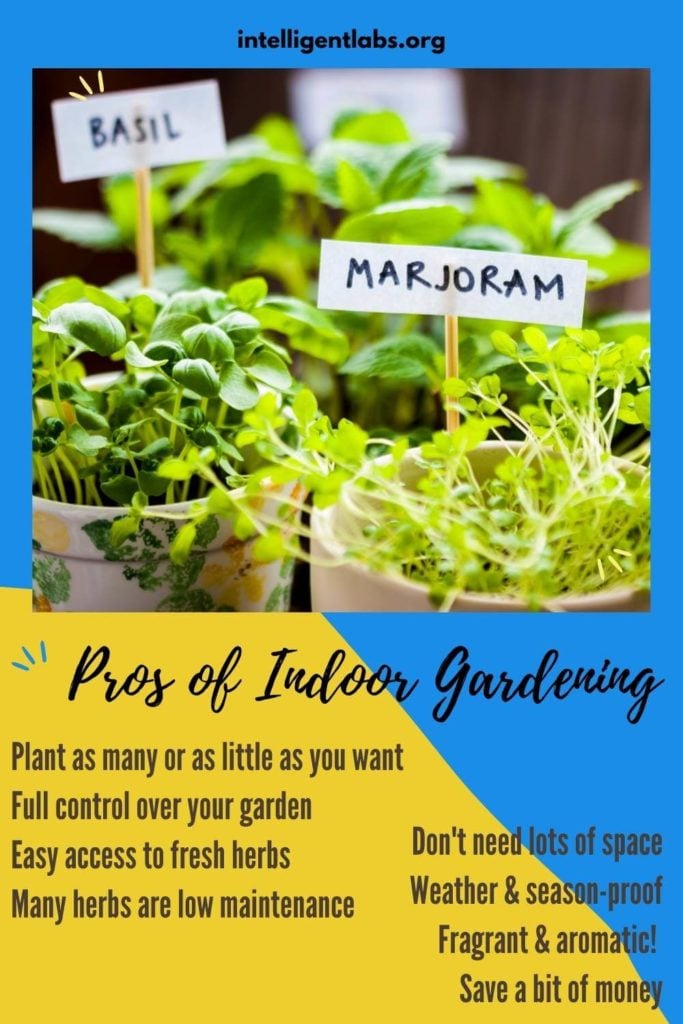
You don’t need to worry about all the pesticides, insecticides, and synthetic fertilizers that goes on most of the herbs, fruits, and veggies you buy at the supermarket. You can choose to go 100% organic for your precious herbs!
- Easy access to fresh herbs
You don’t need to rush to the grocery just to buy some herbs, simply pick them from your garden. Of course, don’t forget to wash the herbs first before using, you don’t want tiny insects to unintentionally add a bit of protein to your dish, right?
- Many herbs are low maintenance
Lots of plants require some tender loving care, especially when grown indoors. However, you’ll be happy to know that there are also many plants that can survive with bi-weekly check-ins.
Here are a few examples – chives, mint, parsley, basil, cilantro, thyme, oregano, lemongrass, and aloe vera.
- You don’t need a lot of space
That’s right, you don’t need lots of space for your indoor garden – many plants will survive with a bit of sunshine and water. The windowsill will work for most herbs, or even the kitchen counter, or wherever you’ve got a bit of space available!
- Weather and season-proof
This is probably the best thing about indoor gardening. You don’t need to worry about plants dying off in the winter and drying out in the summer. As long as you provide the right conditions for your herbs, they can grow all year long. So, you never ever have to run out of your favorite herbs!
- Many herbs are fragrant and aromatic
These herbs will not only add some delicious aroma to whatever dish you add them to, but they’ll also help get rid of any odors in your home. I mean, don’t you just love the idea of coming home to a fresh-smelling house courtesy of your indoor herb garden? I do! You’ll feel relaxed and happy and it will make your home feel like a special sanctuary!
Here are some aromatic herbs you may wish to add to your indoor garden – mint, thyme, lavender, rosemary, basil, and parsley.
- You can also save some money
Most herb seeds are cheap. You can buy them online and have them delivered to your doorstep. Of course, they won’t turn into grown plants overnight, but once the plants have matured, you can compare the cost of the seeds + your time vs. the cost of buying herbs from the supermarket!
But all is not rosy in indoor gardening…
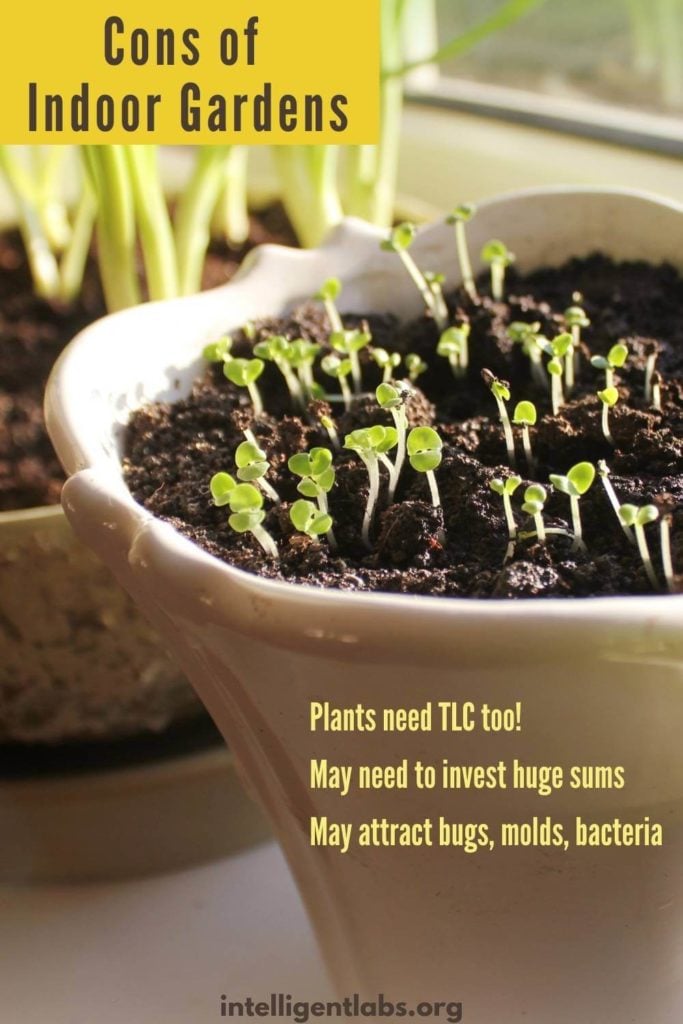
There are also a few downsides to indoor gardening. Here are a few things you need to consider:
- Plants need tender loving care too
Plants are living things, too. So, you need to give them the attention they require if you want them to thrive. Otherwise, they’re just going to wither and die. Before you decide to plant anything, make sure you look up its needs so you can determine if you can handle the responsibility. Oh, and if you plan on being away for long periods of time, you may need to ask a friend to plant-sit for you!
- You may need to invest huge sums of money
A few pots of hardy herbs probably won’t break the bank. But once you get a taste for indoor gardening, you may decide to go all out and spend money on the whole shebang! Here’s a short list – a full spectrum grow lighting system, a watering system, tent system, timers, climate control system, high-quality fertilizers, pesticides, etc. Of course, you don’t need to go all in. In fact, sticking to a simple indoor garden setup is recommended for beginner and intermediate gardeners!
- Your plants may attract bugs, molds and bacteria
If not properly cared for, you may reap more than what you’ve sown. Since most indoor plants have limited access to natural sunlight, your garden may soon be home to bacteria, molds, fungi and even bugs!
Did you find our indoor garden ideas useful?
The idea of starting an indoor garden sounds incredibly exciting, doesn’t it? But as you’ve learned in this article, there’s a lot more to it than simply covering a few seeds with soil and then waiting for the seeds to sprout. Don’t forget to do your research on the plants or herbs you’re thinking of growing, especially if you’re doing it to add a bit more homegrown flavor to your cooking!




